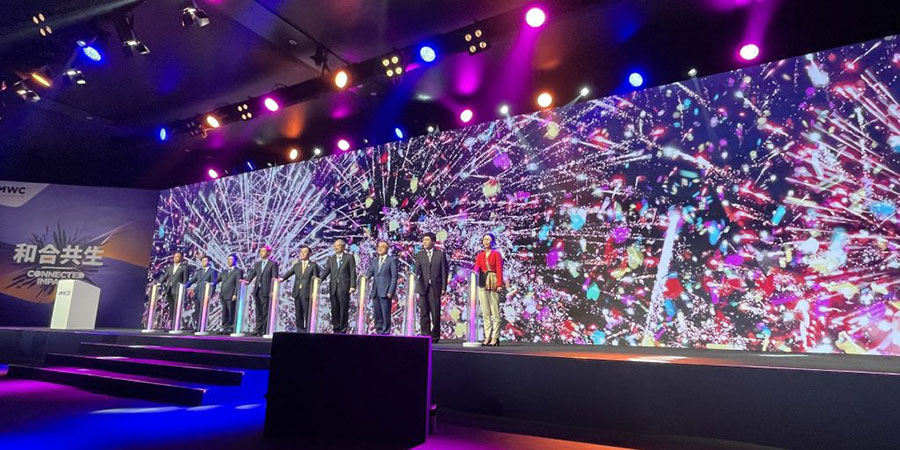MWC Shanghai 2021 kicked off yesterday as the first large-scale hybrid event of its kind, hosted by GSMA. Taking place from 23rd to 25th February, MWC Shanghai 2021 showcases Asia’s mobile industry.
For the first time, a virtual platform, My MWCS Online, has been developed to allow worldwide participants to glean insights from industry leaders.
Under the theme “Connected Impact” to emphasise the global effort and recovery across communities to drive connectivity and transform lives, the event is held at the Shanghai New International Expo Centre, opening doors to over 200 exhibitors and sponsors such as Huawei, ZTE, Qualcomm, Nokia, Samsung, Seagate, and STMicroelectronics.
One of the highlights of this hybrid event is 5GIN, the new 5G Innovation Zone comprising 80 exhibitors to provide immersive 5G experiences leveraging China Telecom’s 5G, cloud XR and digital twin technology.
MWC Shanghai highlights
A common thread in many speeches and summits is accelerated digital transformation owing to COVID-19 and the effort to empower continued digitalisation to benefit industries, economies and lives.
In his keynote address, Mats Granryd, director general of GSMA shared that 1 year of mobile broadband coverage reduces extreme poverty by 5%. He noted that the enterprise market is where technology is most transformative and by 2030, an estimated $700 billion revenue per year will be generated by industry sectors.
Mirroring the sentiments that the enterprise market is key, Huawei officially launched the 5GtoB Suite as the first automated 5GtoB network management platform to offer enterprise customers specialised service capabilities. Huawei also commercially launched its RuralStar Pro solution, designed with integrated access and backhaul (IAB) model to lower deployment costs in rural precincts. Huawei shared how it brought reforms to manufacturing, deploying sophisticated 5G networks to reduce staffing by 80% and raising efficiency by threefold. In a product launch, Huawei also released its Huawei PNI- NPN Kite-like Solution. For the consumer market, Huawei unveils Mate X2 foldable dual-screen phone.
Similarly targeting the enterprise market, ZTE rolled out the i5GC network solution for private 5G networks. This solution combines 5G, AI, IoT, cloud computing, big data and MEC to support digitalisation of whole industries, using 2U general servers to integrate various network functions and plug-and-play deployments.
In his keynote address, Xu Ziyang, ZTE president noted how ZTE is offering better access technology such as enhanced uplink of 5G networks and network slicing, as well as low-latency connectivity of PON. For consumers, ZTE increased high-rise coverage by about a-third with Massive MIMO SSB 1+X beam broadcasting solution and improved 5G indoor coverage using eDAS for UL/DL multi-stream transmission. ZTE also launched its second-generation under display camera technology.
In his keynote speech, Pekka Lundmark, president and CEO of Nokia, cited key traits of future connectivity, namely carrier-grade performance, mission critical applications such as railways, as well as flexibility and elasticity to ensure peak performance.
In their speeches, Rima Qureshi, chief strategy officer of Verizon and Ken Hu, rotating chairman of Huawei warned of a growing digital divide and the need to address this issue. Verizon has developed a 3-year plan to work jointly with the World Economic Forum and partners to bring impact to verticals, geared towards financial, healthcare and education sectors. Huawei cited how it had deployed about 2,000 base stations in Ghana to significantly improve mobile coverage and improve quality of lives.
Yang Jie, chairman of China Mobile urged new developments for the ICT industry, and promoted digitalised and intelligent transformation as the new hallmark. As an example, he cited China Mobile’s role in helping build a smart port in China.
During the Digital Government Summit, discussion was held regarding evolving policies and regulations to support industrial and societal needs.
During the IoT Summit, it was shared that 90% of traffic accidents result from misjudgements. With autonomous driving, 11,000 traffic accidents can be saved, on top of reduced carbon emission and higher efficiency. One of the topics discussed is the adoption of C-V2X technology as the preferred roadmap. Vodafone shared expertise on connected mobility and enhancing road safety in societies.





